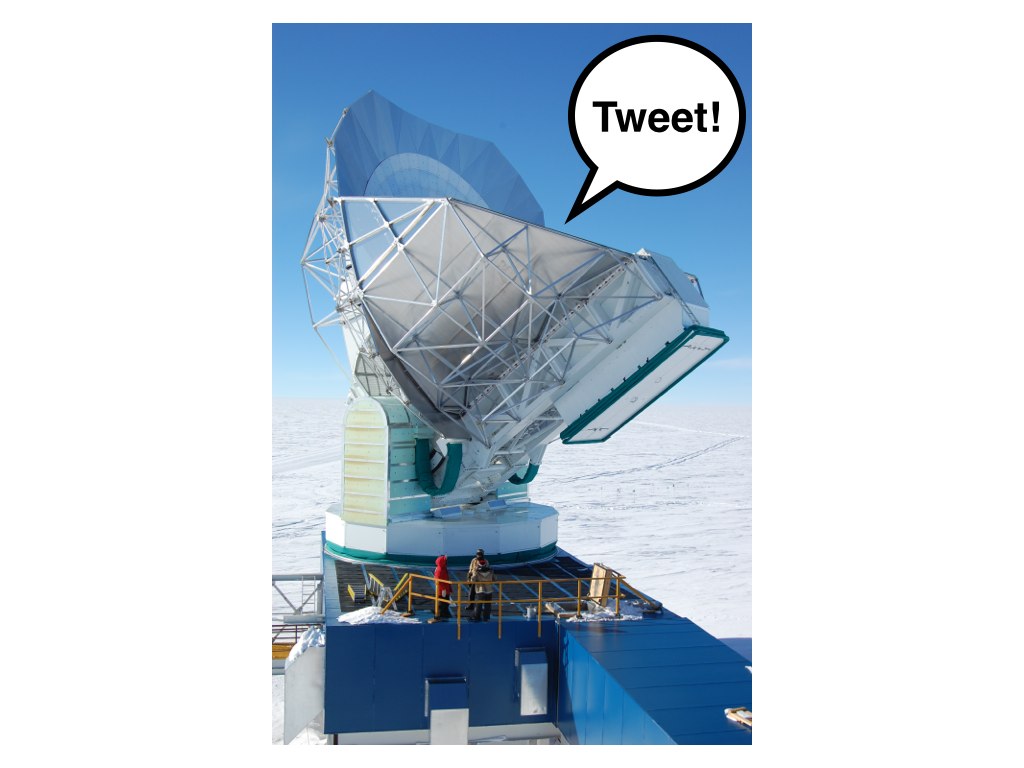Tuesday, January 28. 2014
Big Science With The SPT
In a previous blog post, Wendy Everett described a typical working day in the life of SPT and explained how the various parts of the system operate. Now that you know how the telescope and receiver work, in this post, I'll try to give an idea of why.
As you probably know by now, the SPT was designed and built from the ground up to look at one source: the Cosmic Microwave Background (CMB). The CMB is the name we give to the radiation that has been streaming through the Universe for 14 billion years, since the moment that the Universe became electrically neutral and thus transparent to light (photons, or light particles, interact very strongly with charged matter but not so much with neutral matter). Each CMB photon that is detected here on Earth (or in near-Earth space) carries with it some information about the location in the Universe from which it was emitted. In this way, maps of the CMB are effectively baby pictures of the Universe, giving us a snapshot of the conditions only a few hundred thousand years after the Big Bang.
For a moment, let's flash back to the year 2001. Ever since the Differential Microwave Radiometer (DMR) instrument on the COBE satellite detected tiny (1 part in 10,000) intensity variations on scales of several degrees in the otherwise extremely uniform intensity of the CMB, the race had been on to measure the amplitude of intensity fluctuations at all angular scales, or the power spectrum of the CMB. Of particular interest was the fluctuation power at roughly 1-degree scales (about the angular size of the sun or moon). The leading model for the formation and evolution of the Universe predicted that there should be a series of peaks in fluctuation amplitude as a function of angular scale, with the fundamental peak occurring somewhere around one degree. The exact location of the peak could tell us a very important piece of information, namely whether the Universe was spatially curved or flat. Measurements of further peaks could tell us, among other things, the amounts of dark matter and normal matter in the Universe. All in all, a measurement of the CMB power spectrum out to the third acoustic peak or so would provide enormous amounts of information on the nature of the Universe and represent a cornerstone of our understanding of cosmology.
Through the 1990's, many experiments from the ground and balloons made important but incremental contributions to measuring the CMB power spectrum, mostly putting one or two data points on the plot with large error bars. But a series of experiments---including the Boomerang and Maxima balloon-borne telescopes and the DASI interferometer---released data right around the turn of the millenium that clearly showed the location of the first acoustic peak and strong hints of the second and third peaks. Furthermore, in the spring of 2001, the Wilkinson Microwave Anisotropy Probe (WMAP) satellite was launched. If successful (spoiler: it was), the WMAP mission would extract nearly all the fundamental cosmological information from the CMB intensity fluctuations at angular scales larger than roughly third of a degree (out to the third acoustic peak in the power spectrum). If you were a CMB researcher at the time, what do you do next?

The two aspects of the CMB that WMAP would not measure definitively are the small-scale (smaller than 1/3 of a degree) intensity variations and the polarization. A word about each of these in turn. Although the basic cosmological information in the CMB is encoded in the large- and medium-scale intensity fluctuations, there is much to be learned from the small-scale CMB. For instance, the influence of the elusive subatomic particle known as the neutrino can be detected in the statistics of the small-scale CMB. In 2001, however, the most exciting potential science in the small-scale CMB involved the CMB's interaction with massive clusters of galaxies. The Nobel-prize-winning discovery in 1998 that the expansion of the Universe was accelerating, not slowing down as we all expected, along with the observation from the first acoustic peak in the CMB power spectrum that the Universe was spatially flat, led to the strange but inevitable conclusion that the energy density of the Universe was dominated not by normal or dark matter, but by an unknown entity dubbed "dark energy". About the only thing we know about dark energy is that it has negative pressure and is responsible for the accelerated expansion. It turns out that one way to learn more about dark energy is to study its influence on the growth of structure in the Universe. Galaxy clusters are great tracers of structure growth, so a survey of the abundance of galaxy clusters across cosmic time would potentially tell us important information about dark energy. One problem is that galaxy clusters get very hard to detect at great distances---at least by traditional methods---because distant things are faint. But the interaction between the hot, ionized gas in galaxy clusters and the photons of the CMB---a phenomenon known as the Sunyaev-Zel'dovich, or SZ, effect---leaves an imprint on the CMB which is distance-independent. So a survey of clusters through the SZ could produce a catalog of clusters out to the greatest distances---and, equivalently, the earliest times---at which they exist. Small telescopes such as the 1.5-meter mirror on the WMAP satellite are not sufficient to pick out the arcminute-scale (1/60 of a degree) imprint of galaxy clusters on the CMB; a much larger telescope would be necessary. The SZ signal from galaxy clusters is also small in amplitude compared to the primary CMB, so significant advances in detector sensitivity would also be needed.
The polarization of the CMB promised equally exciting science returns and seemed equally daunting to measure. Like any electromagnetic radiation, the CMB is characterized not only by its intensity but also by the direction in which the electromagnetic wave is oriented. In general, two effects can cause the CMB in one part of the sky to be preferentially polarized a certain way: 1) During the transition of the Universe from charged to neutral (or opaque to transparent), the intensity fluctuations can impart a polarization on the CMB (for more details, see Wayne Hu's CMB tutorials); 2) a background of gravitational waves can stretch and strain the spacetime in which the CMB is embedded, giving rise to a net polarization. Nature has been kind to us and given these two sources of polarization distinct signatures. The polarization that comes from the intensity fluctuations can only produce even-parity modes of polarization ("even parity" means something looks the same when you see it in a mirror), whereas gravity waves can cause even- and odd-parity modes. We often call the even- and odd-parity modes "E" and "B" modes in analogy to electromagnetism. The E modes had to exist if our cosmological model was right (and indeed they were detected by the DASI interferometer in 2002), but the B modes due to gravity-wave were (and are) a more exotic target. Among the many theories for the very first fraction of a second of the Universe, the most successful in predicting cosmological observables is the theory of cosmic inflation, in which a tiny patch of space is thought to have expanded by many orders of magnitude in the first tiny fraction of cosmic time, to become the observable Universe today. A background of gravity waves of a particular intensity is a signature of inflation, and detecting the B modes from these gravity waves would be not only a spectacular confirmation of the theory but would also give us a measurement of physics at the earliest time and highest energy we will ever have access to. Even more so than the SZ effect from clusters, this signal is expected to be extremely faint (at least 1000 times fainter than the CMB intensity fluctuations), so detecting the gravity-wave B modes would need major improvements in both raw instrument sensitivity and control of contaminating signals.
Call us ambitious or greedy, the people that proposed, designed, and built the SPT and its cameras decided to go for both of these science goals. We knew that to resolve distant galaxy clusters with the SZ effect, we needed a large dish (a 10-meter mirror at an observing wavelength of 2 millimeters can resolve structure down to an arcminute, which is just right for distant clusters), and to detect the number of clusters we needed for an interesting constraint on dark energy, we needed a very powerful receiver. To minimize the effect of contaminating signals due to light bouncing off parts of the telescope, we needed a telescope designed explicitly for CMB observations, and to minimize the contaminating effect of the Earth's atmosphere, we needed to put the telescope at high, dry, and atmospherically stable site. And if we went to all the trouble of building a dedicated 10-meter CMB telescope with an unprecedentedly powerful receiver at the South Pole, why not also use it to go after CMB polarization?
So far, at least, we have not been punished for this hubris. The first receiver on the SPT, which was sensitive to intensity only, not polarization, did indeed find many distant galaxy clusters through the SZ effect. A paper is about to come out with the full cluster catalog from the survey with the first receiver, along with the constraints on dark energy and other cosmological parameters. We expect this result to provide the best current constraints on dark energy from the growth of structure and, when combined with other cosmological information, to be the best constraint yet on dark energy. The data from this same survey were also used to measure the power spectrum of the CMB intensity to very small angular scales and, when combined with the WMAP results, provide (among other things) interesting hints about the nature of the neutrino. Finally, the receiver currently on the SPT, which is sensitive to both intensity and polarization, recently made the first detection of B modes in the CMB polarization. Interestingly, these were not the gravity-wave B modes I told you about earlier. I neglected to mention then that odd-parity or B modes can be produced by distorting a pure E-mode pattern. Such a distortion can (and does) happen when CMB photons have their paths deflected by the gravitational influence of structure in the Universe, a phenomenon known as gravitational lensing. The polarization information from the SPT was used last July to detect this effect, and this result was named one of the top 10 results in physics for the year 2013.
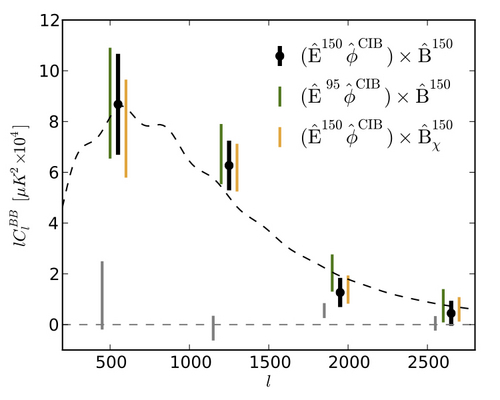
The next few years of SPT observations will bring even more exciting discoveries. Along with other CMB polarization experiments such as BICEP/Keck, Polarbear, and ACTPol, SPT will make yet more sensitive measurements of the E-mode and lensing B-mode signals and possibly even a detection of the gravity-wave B modes. In the meantime, SPT will find yet more distant and exciting galaxy clusters and further refine our knowledge of the intensity fluctuations in the CMB. Stay tuned!
As you probably know by now, the SPT was designed and built from the ground up to look at one source: the Cosmic Microwave Background (CMB). The CMB is the name we give to the radiation that has been streaming through the Universe for 14 billion years, since the moment that the Universe became electrically neutral and thus transparent to light (photons, or light particles, interact very strongly with charged matter but not so much with neutral matter). Each CMB photon that is detected here on Earth (or in near-Earth space) carries with it some information about the location in the Universe from which it was emitted. In this way, maps of the CMB are effectively baby pictures of the Universe, giving us a snapshot of the conditions only a few hundred thousand years after the Big Bang.
For a moment, let's flash back to the year 2001. Ever since the Differential Microwave Radiometer (DMR) instrument on the COBE satellite detected tiny (1 part in 10,000) intensity variations on scales of several degrees in the otherwise extremely uniform intensity of the CMB, the race had been on to measure the amplitude of intensity fluctuations at all angular scales, or the power spectrum of the CMB. Of particular interest was the fluctuation power at roughly 1-degree scales (about the angular size of the sun or moon). The leading model for the formation and evolution of the Universe predicted that there should be a series of peaks in fluctuation amplitude as a function of angular scale, with the fundamental peak occurring somewhere around one degree. The exact location of the peak could tell us a very important piece of information, namely whether the Universe was spatially curved or flat. Measurements of further peaks could tell us, among other things, the amounts of dark matter and normal matter in the Universe. All in all, a measurement of the CMB power spectrum out to the third acoustic peak or so would provide enormous amounts of information on the nature of the Universe and represent a cornerstone of our understanding of cosmology.
Through the 1990's, many experiments from the ground and balloons made important but incremental contributions to measuring the CMB power spectrum, mostly putting one or two data points on the plot with large error bars. But a series of experiments---including the Boomerang and Maxima balloon-borne telescopes and the DASI interferometer---released data right around the turn of the millenium that clearly showed the location of the first acoustic peak and strong hints of the second and third peaks. Furthermore, in the spring of 2001, the Wilkinson Microwave Anisotropy Probe (WMAP) satellite was launched. If successful (spoiler: it was), the WMAP mission would extract nearly all the fundamental cosmological information from the CMB intensity fluctuations at angular scales larger than roughly third of a degree (out to the third acoustic peak in the power spectrum). If you were a CMB researcher at the time, what do you do next?

The WMAP + SPT measurement of the CMB intensity power spectrum. The script l refers to angular scale: l=200 is about one degree.
The two aspects of the CMB that WMAP would not measure definitively are the small-scale (smaller than 1/3 of a degree) intensity variations and the polarization. A word about each of these in turn. Although the basic cosmological information in the CMB is encoded in the large- and medium-scale intensity fluctuations, there is much to be learned from the small-scale CMB. For instance, the influence of the elusive subatomic particle known as the neutrino can be detected in the statistics of the small-scale CMB. In 2001, however, the most exciting potential science in the small-scale CMB involved the CMB's interaction with massive clusters of galaxies. The Nobel-prize-winning discovery in 1998 that the expansion of the Universe was accelerating, not slowing down as we all expected, along with the observation from the first acoustic peak in the CMB power spectrum that the Universe was spatially flat, led to the strange but inevitable conclusion that the energy density of the Universe was dominated not by normal or dark matter, but by an unknown entity dubbed "dark energy". About the only thing we know about dark energy is that it has negative pressure and is responsible for the accelerated expansion. It turns out that one way to learn more about dark energy is to study its influence on the growth of structure in the Universe. Galaxy clusters are great tracers of structure growth, so a survey of the abundance of galaxy clusters across cosmic time would potentially tell us important information about dark energy. One problem is that galaxy clusters get very hard to detect at great distances---at least by traditional methods---because distant things are faint. But the interaction between the hot, ionized gas in galaxy clusters and the photons of the CMB---a phenomenon known as the Sunyaev-Zel'dovich, or SZ, effect---leaves an imprint on the CMB which is distance-independent. So a survey of clusters through the SZ could produce a catalog of clusters out to the greatest distances---and, equivalently, the earliest times---at which they exist. Small telescopes such as the 1.5-meter mirror on the WMAP satellite are not sufficient to pick out the arcminute-scale (1/60 of a degree) imprint of galaxy clusters on the CMB; a much larger telescope would be necessary. The SZ signal from galaxy clusters is also small in amplitude compared to the primary CMB, so significant advances in detector sensitivity would also be needed.
The polarization of the CMB promised equally exciting science returns and seemed equally daunting to measure. Like any electromagnetic radiation, the CMB is characterized not only by its intensity but also by the direction in which the electromagnetic wave is oriented. In general, two effects can cause the CMB in one part of the sky to be preferentially polarized a certain way: 1) During the transition of the Universe from charged to neutral (or opaque to transparent), the intensity fluctuations can impart a polarization on the CMB (for more details, see Wayne Hu's CMB tutorials); 2) a background of gravitational waves can stretch and strain the spacetime in which the CMB is embedded, giving rise to a net polarization. Nature has been kind to us and given these two sources of polarization distinct signatures. The polarization that comes from the intensity fluctuations can only produce even-parity modes of polarization ("even parity" means something looks the same when you see it in a mirror), whereas gravity waves can cause even- and odd-parity modes. We often call the even- and odd-parity modes "E" and "B" modes in analogy to electromagnetism. The E modes had to exist if our cosmological model was right (and indeed they were detected by the DASI interferometer in 2002), but the B modes due to gravity-wave were (and are) a more exotic target. Among the many theories for the very first fraction of a second of the Universe, the most successful in predicting cosmological observables is the theory of cosmic inflation, in which a tiny patch of space is thought to have expanded by many orders of magnitude in the first tiny fraction of cosmic time, to become the observable Universe today. A background of gravity waves of a particular intensity is a signature of inflation, and detecting the B modes from these gravity waves would be not only a spectacular confirmation of the theory but would also give us a measurement of physics at the earliest time and highest energy we will ever have access to. Even more so than the SZ effect from clusters, this signal is expected to be extremely faint (at least 1000 times fainter than the CMB intensity fluctuations), so detecting the gravity-wave B modes would need major improvements in both raw instrument sensitivity and control of contaminating signals.
Call us ambitious or greedy, the people that proposed, designed, and built the SPT and its cameras decided to go for both of these science goals. We knew that to resolve distant galaxy clusters with the SZ effect, we needed a large dish (a 10-meter mirror at an observing wavelength of 2 millimeters can resolve structure down to an arcminute, which is just right for distant clusters), and to detect the number of clusters we needed for an interesting constraint on dark energy, we needed a very powerful receiver. To minimize the effect of contaminating signals due to light bouncing off parts of the telescope, we needed a telescope designed explicitly for CMB observations, and to minimize the contaminating effect of the Earth's atmosphere, we needed to put the telescope at high, dry, and atmospherically stable site. And if we went to all the trouble of building a dedicated 10-meter CMB telescope with an unprecedentedly powerful receiver at the South Pole, why not also use it to go after CMB polarization?
So far, at least, we have not been punished for this hubris. The first receiver on the SPT, which was sensitive to intensity only, not polarization, did indeed find many distant galaxy clusters through the SZ effect. A paper is about to come out with the full cluster catalog from the survey with the first receiver, along with the constraints on dark energy and other cosmological parameters. We expect this result to provide the best current constraints on dark energy from the growth of structure and, when combined with other cosmological information, to be the best constraint yet on dark energy. The data from this same survey were also used to measure the power spectrum of the CMB intensity to very small angular scales and, when combined with the WMAP results, provide (among other things) interesting hints about the nature of the neutrino. Finally, the receiver currently on the SPT, which is sensitive to both intensity and polarization, recently made the first detection of B modes in the CMB polarization. Interestingly, these were not the gravity-wave B modes I told you about earlier. I neglected to mention then that odd-parity or B modes can be produced by distorting a pure E-mode pattern. Such a distortion can (and does) happen when CMB photons have their paths deflected by the gravitational influence of structure in the Universe, a phenomenon known as gravitational lensing. The polarization information from the SPT was used last July to detect this effect, and this result was named one of the top 10 results in physics for the year 2013.

Gravitational lensing B modes detected in the polarization data from SPT.
The next few years of SPT observations will bring even more exciting discoveries. Along with other CMB polarization experiments such as BICEP/Keck, Polarbear, and ACTPol, SPT will make yet more sensitive measurements of the E-mode and lensing B-mode signals and possibly even a detection of the gravity-wave B modes. In the meantime, SPT will find yet more distant and exciting galaxy clusters and further refine our knowledge of the intensity fluctuations in the CMB. Stay tuned!
Monday, January 13. 2014
A day in the life of SPT (by Wendy Everett, with a little help from Tom Crawford)
Since the telescope camera is remaining the same this year, most of the summer work has been spent on annual maintenance tasks such as changing oil and greasing gears in anticipation of the oncoming winter. But we're also taking advantage of the relatively light work year to take some data, observing a patch of sky we've never yet looked at to find the most massive galaxy clusters in that part of the sky. What does a typical day look like for SPT when it's taking data?
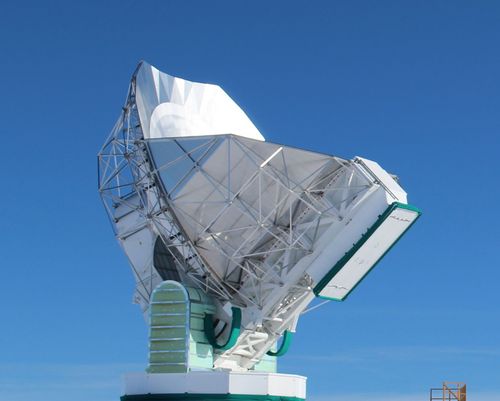 Rather than 24 hours, a day for SPT lasts about 36 hours, which is the length of time our refrigerators can keep the detectors cold. Because SPT is measuring very faint signals (one part in 100,000 or even fainter!), the SPT detectors need to have very little noise due to thermal energy, and we therefore keep them at about 1/4 of a degree above absolute zero Kelvin while we're taking data. Keeping anything that cold involves a complicated layering of refrigerators. In the outer layers, we use pulse tube cryocoolers, which compress and expand gas at different temperatures to remove heat. The inner-most layers involve a recyclable refrigeration system called a sorption fridge, which uses the evaporation of an isotope of Helium, Helium 3. Helium 3 is condensed into a liquid and then a chunk of charcoal acts as a pump to suck up the gas that evaporates. Just like how evaporative cooling helps one's body cool down after exercising, by sucking up the evaporating gas above the liquid Helium 3, the charcoal helps the liquid cools down, and the liquid can be used to cool our detectors.
Rather than 24 hours, a day for SPT lasts about 36 hours, which is the length of time our refrigerators can keep the detectors cold. Because SPT is measuring very faint signals (one part in 100,000 or even fainter!), the SPT detectors need to have very little noise due to thermal energy, and we therefore keep them at about 1/4 of a degree above absolute zero Kelvin while we're taking data. Keeping anything that cold involves a complicated layering of refrigerators. In the outer layers, we use pulse tube cryocoolers, which compress and expand gas at different temperatures to remove heat. The inner-most layers involve a recyclable refrigeration system called a sorption fridge, which uses the evaporation of an isotope of Helium, Helium 3. Helium 3 is condensed into a liquid and then a chunk of charcoal acts as a pump to suck up the gas that evaporates. Just like how evaporative cooling helps one's body cool down after exercising, by sucking up the evaporating gas above the liquid Helium 3, the charcoal helps the liquid cools down, and the liquid can be used to cool our detectors.
Once the charcoal pill has absorbed all of the liquid Helium 3, it can no longer suck up any more heat and everything will start warming up. This means we need to recycle the fridge. To do this, we heat the charcoal to expel and liquify the Helium 3, then cool back down and start the pumping process over again. This cycling limits how long SPT can observe for in a single "day."
After we've cooled the fridge, we prepare SPT for new observations. First, we apply voltage to the detectors and tune the amplifiers. Our detectors are essentially small thermometers which measure the amount of heating that results as CMB photons are absorbed. To make our detectors extremely sensitive, we make them out of a material that goes superconducting at low temperatures and then we apply a voltage to keep each detector in the region of its transition between superconducting and normal. This means that very small changes in temperature cause very large changes in the electrical resistance. Next we tune our readout amplifiers so they are operating in their ideal state. These amplifiers consist of SQUIDs: Superconducting Quantum Interference Devices, which include a current loop that is very sensitive to changes in magnetic flux. We then couple the SQUID readout to our detectors using an inductor. The readout is actually a little more complicated: in order to reduce the number of wires that need to go to each detector (since each wire will also allow some heat to travel to our cold detectors and warm them up), we set each detector to "ring" at a different tone so that we can read out multiple detectors with a single SQUID. This process is known as frequency-domain multiplexing.
Now, SPT is set up to start taking data. While we want to prioritize using SPT's day for observing our science fields on the sky, we also need to do a number of calibration measurements to make sure we can most effectively use our data once we've taken it. Therefore, once our detectors are all ready, SPT continues its morning with a noise stare, where the telescope observes a small blank patch of sky for 10 minutes to get a sense for the amount of instrument noise to expect on that day. Next, we perform calibration measurements at a variety of different elevations in the sky. In order to calibrate the relative power each detector observes, we have an external calibration source, which is a glowing filament sitting behind the secondary mirror, which we can shutter off from the optical chain when it's not in use. The brightness of the calibrator source is anchored to an astrophysical source in the sky (of known brightness) once each day, and then we check in with the detectors using just the calibrator several times in the mean time to make sure nothing strange is happening with any of the detector's response. We measure this response to the calibrator at several different elevations, because looking through different amounts of atmosphere means a slightly different heat load on the detectors, which could mean a slightly different responsivity for the detectors (in reality this effect is tiny, and we can mostly ignore it).
The next step in SPT's day is to make a quick observation of one of the astrophysical calibration sources I mentioned above. These include two galactic HII regions, which are large clouds of ionized Hydrogen within our galaxy. They are mainly useful because they have well-studied properties and don't change day-to-day, so we can use them to calibrate how much power each detector sees. We also use these observations to calibrate the pointing of the telescope. We want to know very precisely where the telescope is looking in the sky, but this can be effected by things like gravitational sag of different parts of the telescope when looking at different elevations or temperature gradients causing differential thermal expansion or contraction, so we combine observations of astrophysical sources with measurements from sensors placed all over the physical body of the telescope to help us create a model of where SPT is looking at any time and orientation.
Now SPT is ready to take measurements of the sky! Right now, we're observing four different sky fields at declination -35 degrees. These fields are two hours wide in right ascension (i.e., twelve of them end-to-end would make a horizontal circle around the sky) and ten degrees high (so nine of them stacked on top of one another would reach from the horizon to the zenith). The telescope scans over these fields by starting at the bottom left of the field, scanning across horizontally at about one half of a degree in azimuth per second (so that crossing the field takes about 1 minute---because two hours of right ascension is 30 degrees in azimuth), scanning back across in the other direction, stepping up a small amount in elevation, and repeating until the whole field is covered. This takes about two and a half hours, and we do 10 or 11 of these observations in one "day".
The SPT computers at the South Pole are set up to automatically process these observations as they come in. The end product of this processing is a map of the field. After only a few observations, we can already see bright emissive sources (usually active galactic nuclei emitting synchrotron radiation) and, if we're lucky, some massive, as-yet-unknown galaxy clusters. Stay tuned!

SPT scans the sky.
Once the charcoal pill has absorbed all of the liquid Helium 3, it can no longer suck up any more heat and everything will start warming up. This means we need to recycle the fridge. To do this, we heat the charcoal to expel and liquify the Helium 3, then cool back down and start the pumping process over again. This cycling limits how long SPT can observe for in a single "day."
After we've cooled the fridge, we prepare SPT for new observations. First, we apply voltage to the detectors and tune the amplifiers. Our detectors are essentially small thermometers which measure the amount of heating that results as CMB photons are absorbed. To make our detectors extremely sensitive, we make them out of a material that goes superconducting at low temperatures and then we apply a voltage to keep each detector in the region of its transition between superconducting and normal. This means that very small changes in temperature cause very large changes in the electrical resistance. Next we tune our readout amplifiers so they are operating in their ideal state. These amplifiers consist of SQUIDs: Superconducting Quantum Interference Devices, which include a current loop that is very sensitive to changes in magnetic flux. We then couple the SQUID readout to our detectors using an inductor. The readout is actually a little more complicated: in order to reduce the number of wires that need to go to each detector (since each wire will also allow some heat to travel to our cold detectors and warm them up), we set each detector to "ring" at a different tone so that we can read out multiple detectors with a single SQUID. This process is known as frequency-domain multiplexing.
Now, SPT is set up to start taking data. While we want to prioritize using SPT's day for observing our science fields on the sky, we also need to do a number of calibration measurements to make sure we can most effectively use our data once we've taken it. Therefore, once our detectors are all ready, SPT continues its morning with a noise stare, where the telescope observes a small blank patch of sky for 10 minutes to get a sense for the amount of instrument noise to expect on that day. Next, we perform calibration measurements at a variety of different elevations in the sky. In order to calibrate the relative power each detector observes, we have an external calibration source, which is a glowing filament sitting behind the secondary mirror, which we can shutter off from the optical chain when it's not in use. The brightness of the calibrator source is anchored to an astrophysical source in the sky (of known brightness) once each day, and then we check in with the detectors using just the calibrator several times in the mean time to make sure nothing strange is happening with any of the detector's response. We measure this response to the calibrator at several different elevations, because looking through different amounts of atmosphere means a slightly different heat load on the detectors, which could mean a slightly different responsivity for the detectors (in reality this effect is tiny, and we can mostly ignore it).
The next step in SPT's day is to make a quick observation of one of the astrophysical calibration sources I mentioned above. These include two galactic HII regions, which are large clouds of ionized Hydrogen within our galaxy. They are mainly useful because they have well-studied properties and don't change day-to-day, so we can use them to calibrate how much power each detector sees. We also use these observations to calibrate the pointing of the telescope. We want to know very precisely where the telescope is looking in the sky, but this can be effected by things like gravitational sag of different parts of the telescope when looking at different elevations or temperature gradients causing differential thermal expansion or contraction, so we combine observations of astrophysical sources with measurements from sensors placed all over the physical body of the telescope to help us create a model of where SPT is looking at any time and orientation.
Now SPT is ready to take measurements of the sky! Right now, we're observing four different sky fields at declination -35 degrees. These fields are two hours wide in right ascension (i.e., twelve of them end-to-end would make a horizontal circle around the sky) and ten degrees high (so nine of them stacked on top of one another would reach from the horizon to the zenith). The telescope scans over these fields by starting at the bottom left of the field, scanning across horizontally at about one half of a degree in azimuth per second (so that crossing the field takes about 1 minute---because two hours of right ascension is 30 degrees in azimuth), scanning back across in the other direction, stepping up a small amount in elevation, and repeating until the whole field is covered. This takes about two and a half hours, and we do 10 or 11 of these observations in one "day".
The SPT computers at the South Pole are set up to automatically process these observations as they come in. The end product of this processing is a map of the field. After only a few observations, we can already see bright emissive sources (usually active galactic nuclei emitting synchrotron radiation) and, if we're lucky, some massive, as-yet-unknown galaxy clusters. Stay tuned!
Friday, November 29. 2013
The Long Journey South
ORD -> LAX -> SYD -> CHC -> MCM -> NPX
The airport codes provide a glimpse of the long journey to the South Pole. While not as harrowing as the epic sea voyages and sledge journeys of Antarctic explorers of old, traveling to 90 S today is still a memorable experience.
For many of us the journey begins in the United States. Leaving behind the chilly late fall weather in Chicago (ORD), I flew to foggy Los Angeles (LAX) where I boarded a 747 for the 14 hr flight to Sydney, Australia (SYD). Shedding my coat in the warm Aussie airport I next hopped a short 2 hour flight to Christchurch (CHC) on the South Island of New Zealand.
Christchurch is the base of the United States Antarctica Program, handling transport of cargo and personnel to the ice. Bright and early the morning after we fly in we are issued the Extreme Cold Weather (ECW) Gear that will keep us safe and comfortable in the harsh Antarctic climate.
The ECW takes up two large duffle bags and includes:
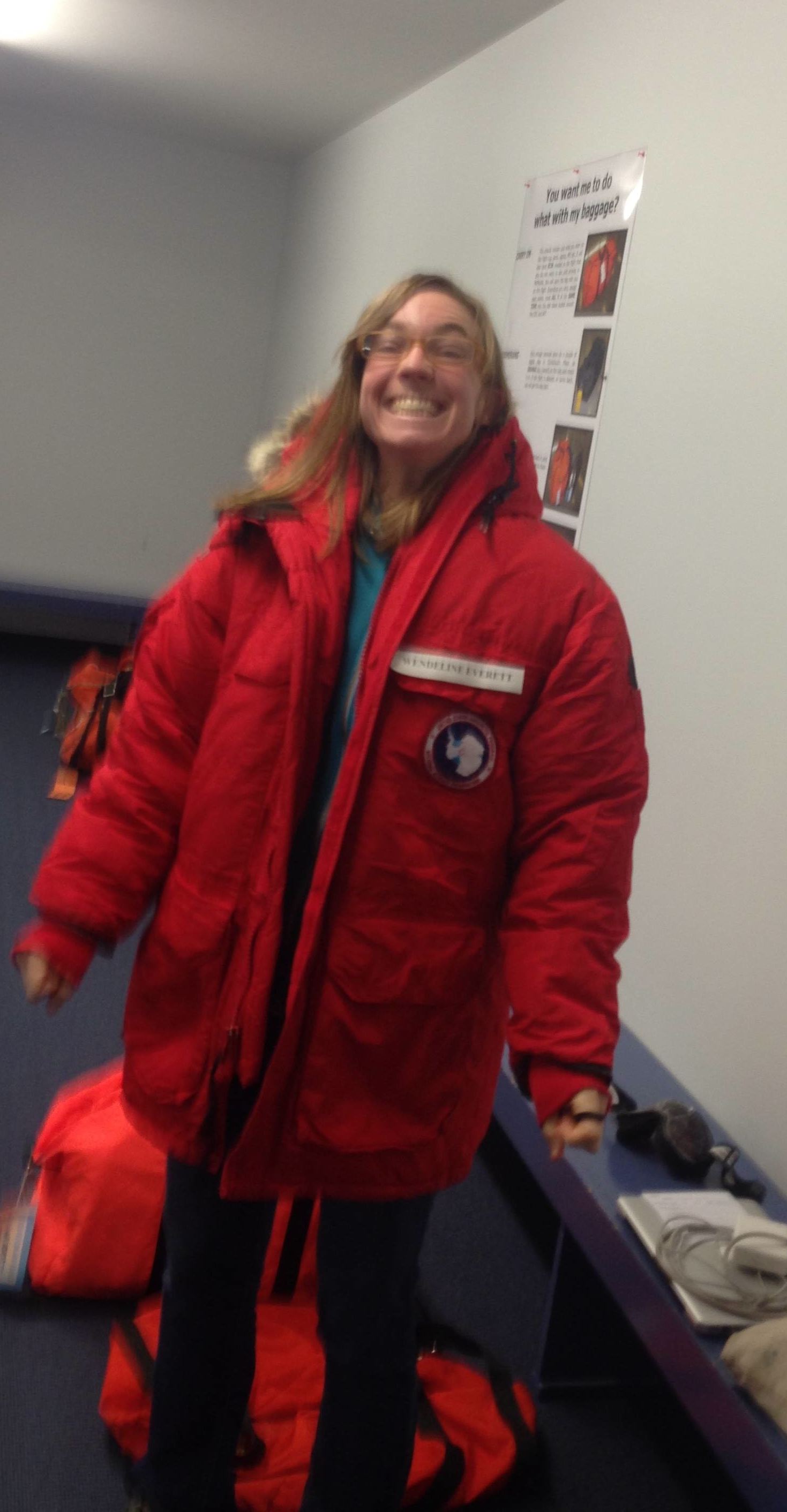
• Knit cap
• Balaclava
• Ski Goggles — Critical, as the glare is incredible (everything is snow-covered and the sun is up 24 hours/day)
• Neck Gator
• “Big Red” — A big down jacket. As almost everyone has the exact same jacket and is bundled up from head to toe, you quickly learn to identify people by their hats, goggles, height or gait.
• Carhartts (thick overalls) or snow pants
• Mittens, gloves, glove liners (we also insert hand warmers when we work outside; touching the cold metal telescope quickly chills our hands even through the gloves)
• Fleeces, Long underwear, thick socks
• “Bunny” boots or FX boots
Following gear issue and various safety and logistical briefings we are free for the day. Now comes one of the best parts of this journey — a day in Christchurch. Christchurch in November (Spring in the Southern Hemisphere) is a haven. It’s a wonderful experience to walk through the Botanical Gardens under the warm sun — the roses are blooming, birds singing, and ducklings waddling about— and is fortifying against the coming bitterly cold and arid weather we will experience in Antarctica.

Stocked up on Freshies (fresh fruits and veggies) and after one last good meal it’s off to the ice! We boarded a C17 that flew us from Christchurch to McMurdo (MCM) on Ross Island Antarctica.

MacTown, as the locals call it, is the main US base in Antarctica. With a population of roughly 800 people in the summer, it’s a key logistics center. Flights from Christchurch ferry in personnel and supplies that are then sent off to bases and field camps across the Antarctic continent. Keeping the system running smoothly can be challenging. Our flight from Christchurch was delayed a day and flights to the South Pole had been backed up for a week owing to bad weather. Fortunately for us, our flight out of MacTown took off on schedule. An LC-130 transported us from sea-level Ross Island across the beautiful barren landscape to the high Antarctic plateau where we landed at South Pole Station (NPX), our home for the coming months.

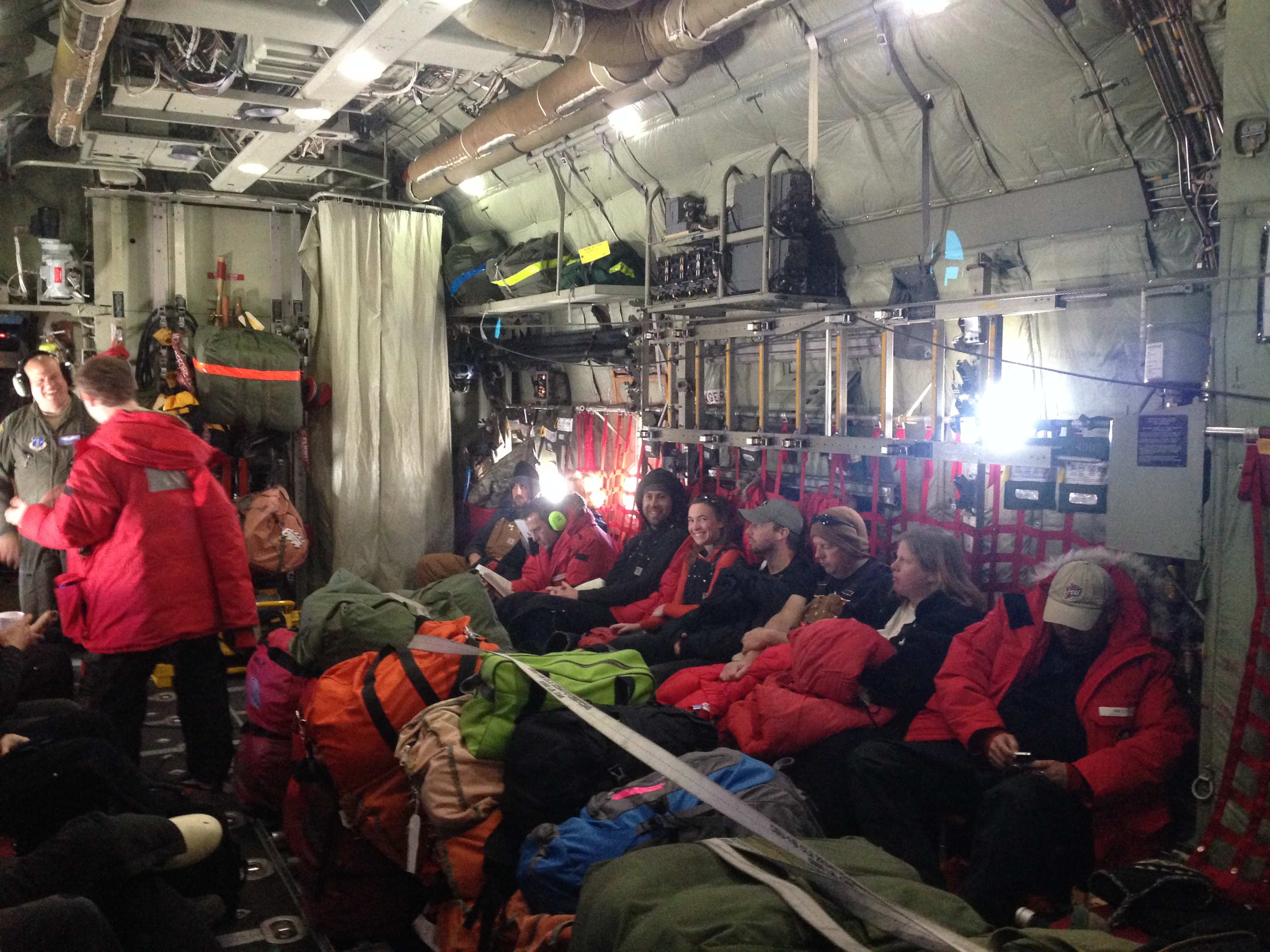
For more photos of Christchurch and McMurdo check out this link.
The airport codes provide a glimpse of the long journey to the South Pole. While not as harrowing as the epic sea voyages and sledge journeys of Antarctic explorers of old, traveling to 90 S today is still a memorable experience.
For many of us the journey begins in the United States. Leaving behind the chilly late fall weather in Chicago (ORD), I flew to foggy Los Angeles (LAX) where I boarded a 747 for the 14 hr flight to Sydney, Australia (SYD). Shedding my coat in the warm Aussie airport I next hopped a short 2 hour flight to Christchurch (CHC) on the South Island of New Zealand.
Christchurch is the base of the United States Antarctica Program, handling transport of cargo and personnel to the ice. Bright and early the morning after we fly in we are issued the Extreme Cold Weather (ECW) Gear that will keep us safe and comfortable in the harsh Antarctic climate.
The ECW takes up two large duffle bags and includes:

Big Red!
• Knit cap
• Balaclava
• Ski Goggles — Critical, as the glare is incredible (everything is snow-covered and the sun is up 24 hours/day)
• Neck Gator
• “Big Red” — A big down jacket. As almost everyone has the exact same jacket and is bundled up from head to toe, you quickly learn to identify people by their hats, goggles, height or gait.
• Carhartts (thick overalls) or snow pants
• Mittens, gloves, glove liners (we also insert hand warmers when we work outside; touching the cold metal telescope quickly chills our hands even through the gloves)
• Fleeces, Long underwear, thick socks
• “Bunny” boots or FX boots
Following gear issue and various safety and logistical briefings we are free for the day. Now comes one of the best parts of this journey — a day in Christchurch. Christchurch in November (Spring in the Southern Hemisphere) is a haven. It’s a wonderful experience to walk through the Botanical Gardens under the warm sun — the roses are blooming, birds singing, and ducklings waddling about— and is fortifying against the coming bitterly cold and arid weather we will experience in Antarctica.

Rose Garden in Botanical Gardens, Christchurch, NZ
Stocked up on Freshies (fresh fruits and veggies) and after one last good meal it’s off to the ice! We boarded a C17 that flew us from Christchurch to McMurdo (MCM) on Ross Island Antarctica.

On the C-17, flying to Antarctica!
MacTown, as the locals call it, is the main US base in Antarctica. With a population of roughly 800 people in the summer, it’s a key logistics center. Flights from Christchurch ferry in personnel and supplies that are then sent off to bases and field camps across the Antarctic continent. Keeping the system running smoothly can be challenging. Our flight from Christchurch was delayed a day and flights to the South Pole had been backed up for a week owing to bad weather. Fortunately for us, our flight out of MacTown took off on schedule. An LC-130 transported us from sea-level Ross Island across the beautiful barren landscape to the high Antarctic plateau where we landed at South Pole Station (NPX), our home for the coming months.

A view on the LC-130 flight from McMurdo to South Pole Station

On the way to Pole!
For more photos of Christchurch and McMurdo check out this link.
Monday, December 10. 2012
There is a Cold Temperature Alarm in the Dark Sector
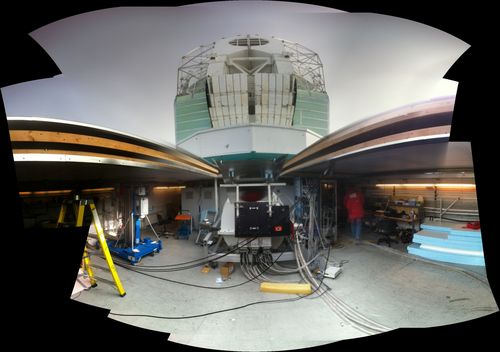
Taking measurements with the SPTpol receiver, with the SPT telescope overhead. We have the control room roof open, and have a reflecting aluminum sheet to couple the beam of the receiver to the sky. Our detectors need to look at something really cold, like the sky, otherwise they will saturate and not work well.
The SPTpol receiver camera is cold, and we are doing on-the-ground tests to make sure all our improvements for our second observing season are working. So far things are looking great. We we are cycling our He3 fridge successfully, and the loading on it is reduced / improved as inspected, due to some clever re-arranging of our infrared / heat blocking filters. The new NIST 150 GHz detector module is working great, the readout and detector yield looks better than ever, new robust readout electronics algorithms are working great, and we have some early indications that our efforts to improve the detector band-width are working. We have probably another ~5 days of tests of the receiver on the ground, not in the telescope, and it should be ready to go back on.
In parallel, Erik is leading a crew (Josh, Ryan, Don) working on the co-moving ground shield extension for the telescope, designed to reduce ground pickup at the level we need for our polarization measurements of the cosmic microwave background. Over the last 10 days, work has progressing rapidly, and it should be ready by Christmas!
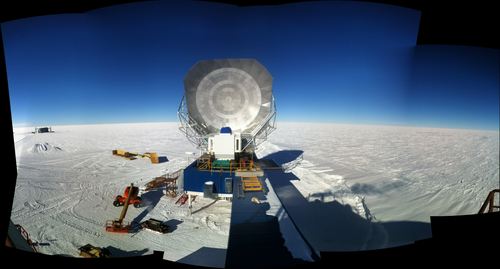
Work continues on the telescope to extend the SPT co-moving ground shield. Its about 2 weeks away from completion!
Thursday, December 6. 2012
The SPTpol Receiver is open!
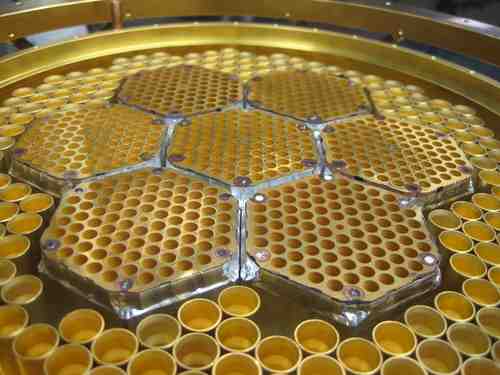
A close up picture of the SPTpol focal plane. Each circle is a feedhorn that couples light to the detectors below. The smaller (5 mm diameter) circles are our 150 GHz detectors, and the larger circles are our 90 GHz detectors.
This weekend we were very busy; we opened up the receiver, made several small fixes, closed it back up again, and just started cooling down again yesterday. This post will take you through that whole process.
After opening up the receiver the first thing we wanted to do was take out the focal plane. We knew we wanted to replace one (of seven) module of 150 GHz (2-mm wavelength) detectors, but still wanted to inspect it to see if we could find an obvious problem. We did not, so Jason swapped it out for the spare detector wafer. We also wanted to replace two of our four focal plane infrared filters, to increase the bandwidth of light that we are sensitive to, which ultimately improves our sensitivity.
While the most glamorous part of the re-work was the focal plane, which is also what most of my post is dedicated to. Jay and I were primarily working on the receiver cryostat, installing a new lens filter, and modifying the focal plane baffle to fit with the new parts. In addition, we replaced 1/6 of our SQUIDs, in attempt to fix some bad readout channels that didnt work, and are switching over to a more stable feedback algorithm which should bring back a couple dozen of our detectors.
Late Monday afternoon, we got the receiver and optics cryostat re-attached, and soon started pumping them down; we need to get the crysotats to a pressure about 100 million times less pressure than atmospheric pressure. Then on Tuesday afternoon, we turned on the pulse tubes and started cooling the cryostats down.
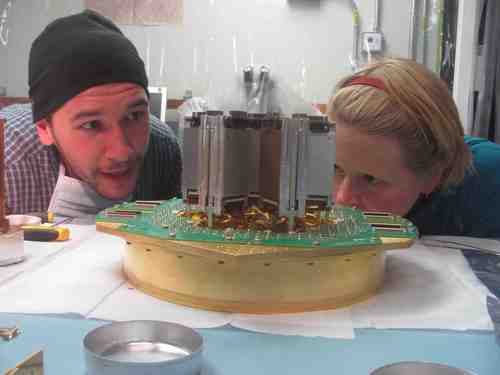
Jason and Liz inspecting the back of the SPTpol focal plane.
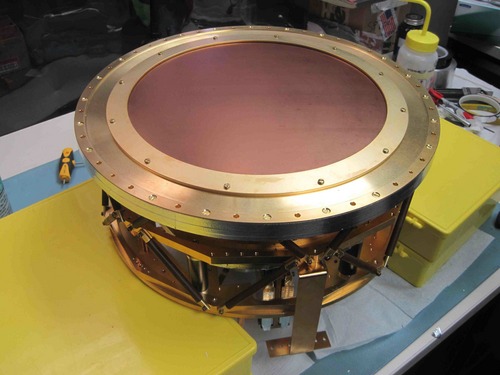
The assembled SPTpol focal plane. The copper filter pictured is one of our blocking filters at 4 Kelvin, about 1 inch behind which are the feedhorns, and about 1 inch behind those are the detectors.
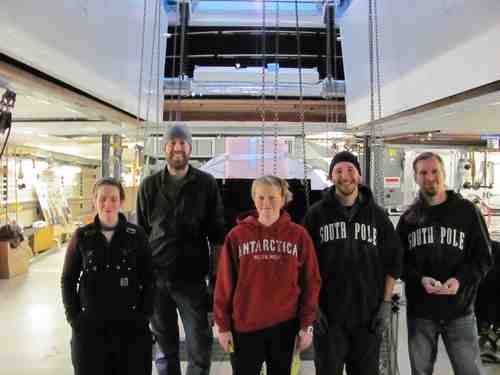
The SPTpol receiver team this year: Amy Bender (McGill), Brad Benson (Chicago), Liz George (Berkeley), Jason Henning (Colorado), Jay Austermann (Colorado). Not pictured: Tijmen de Haan (McGill).
Wednesday, December 5. 2012
Polarization Calibration at the South Pole

Caption: Tijmen, Amy, and Ryan in front of the SPT calibration source located about 3 km away from SPT. The reflecting panel is about 20 feet tall, covered with aluminum siding that acts as a mirror for microwaves. It is tilted at 30 degrees so that reflections go to 60 degrees elevation, and the squarish hole in the middle contains a chopped, polarized source for us to measure our detector polarization angles.
The last few weeks we have been finishing up calibrating the polarization angles of the SPT detectors. This requires the SPT to re-focus on a source 3 kilometers away from the telescope, and detecting the signal from a ~1 inch square source. The source is a hot filament, behind a plastic lens that directs the light to the telescope. In front of the lens is a rotating polarizing grid, that is modulated at 7.5 Hz, which we lock into while keeping track of the position of the polarizing grid. Using these measurements, we can measure the exact polarization angle of our detectors.
There are a few challenges doing this measurement. First, we can't focus on anything closer than 3 kilometers away, so we had to build the source that far away from the telescope, or about 4 kilometers away from the South Pole Station. Its way out there, and requires about a 15 minute snow-mobile ride just to get there. We have a little warming hut out there to keep us warm, but it definitely puts in perspective the need to stay warm and be careful.
Second, our detectors are designed to look high up in the sky and are saturated when looking at the horizon. To get around this, we built a ~20 foot tall reflector, that reflects the majority of our beam to the sky. In the center of the reflector is our calibration source, which as I said above, is behind a rotating polarizing grid. We have to measure each one of our detectors one at a time, so to measure the polarization angle of every detector on the focal plane of the camera takes about 40 hours of working, uninterrupted measurements.
Third, even with this setup, some of the detectors barely operate correctly. We had to take the measurements in a variety of configurations, and it took a lot of care to get measurements for even ~90% of the focal plane. Anyway, we think we figured out how to do it right, which is important because we will need to repeat these measurements in late December, early January, after we re-configure the SPTpol focal plane.
Last week, we finally took the SPTpol camera and secondary mirror out of the telescope cabin, and opened them up. We will post more pictures and comments on that progress soon, but so far so good!

The view from the back of the reflector. The calibration source is on the ledge, the station is the bluish blob in the distance at the right of the image.
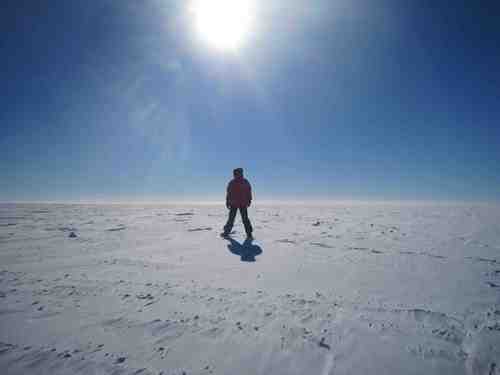
Looking away from the station with Brad standing under the sun. The horizon basically looks like this in every direction; the South Pole is very flat and featureless.
Thursday, November 8. 2012
Summer returns to the South Pole
It's early November--the start of summer at the South Pole, which means a large crew of SPTpol folks are headed down to the pole to start upgrade work on the camera. In fact, our first wave of summer folks arrived at the South Pole yesterday to finish up polarization calibration of the current receiver configuration before we take it apart for upgrades. Special thanks to winterovers Cynthia Chang and Nicholas Huang, who have spent the last 9 months at the South Pole running the telescope, taking data, and fixing any unexpected problems that cropped up. In the next few days (after they hand off telescope duties to the summer crew), they will be headed home for a well-deserved vacation.
We have several upgrades slated for this season. We are changing our observing bands slightly and replacing a subset of detectors to optimize sensitivity, improving the hold time of our cryogenic refrigerator, adding more co-moving ground shields to the telescope, and updating some of our readout so that we have the option of using digital active nulling (DAN) for readout if we want. A group of SPTpol students and post-docs attended SPIE this summer, and we published proceedings discussing the current state of the instrument, as well as the planned instrument upgrades for this summer. If you are interested in the more technical aspects of the receiver (and this summer's upgrades), check out the proceedings below.
Austermann, et al. 2012 - SPTpol: an instrument for CMB polarization measurements with the South Pole Telescope
de Haan, et al. 2012 - Improved Performance of TES Bolometers using Digital Feedback
George, et al. 2012 - Performance and on-sky optical characterization of the SPTpol instrument
Henning, et al. 2012 - Feedhorn-coupled TES polarimeter camera modules at 150 GHz for CMB polarization measurements with SPTpol
Sayre, et al. 2012 - Design and characterization of 90 GHz feedhorn-coupled TES polarimeter pixels in the SPTpol camera
Story, et al. 2012 - South Pole Telescope Software Systems: Control, Monitoring, and Data Acquisition
It's going to be a busy season, but we're all excited about the instrument and the tasks ahead for the summer.
We have several upgrades slated for this season. We are changing our observing bands slightly and replacing a subset of detectors to optimize sensitivity, improving the hold time of our cryogenic refrigerator, adding more co-moving ground shields to the telescope, and updating some of our readout so that we have the option of using digital active nulling (DAN) for readout if we want. A group of SPTpol students and post-docs attended SPIE this summer, and we published proceedings discussing the current state of the instrument, as well as the planned instrument upgrades for this summer. If you are interested in the more technical aspects of the receiver (and this summer's upgrades), check out the proceedings below.
Austermann, et al. 2012 - SPTpol: an instrument for CMB polarization measurements with the South Pole Telescope
de Haan, et al. 2012 - Improved Performance of TES Bolometers using Digital Feedback
George, et al. 2012 - Performance and on-sky optical characterization of the SPTpol instrument
Henning, et al. 2012 - Feedhorn-coupled TES polarimeter camera modules at 150 GHz for CMB polarization measurements with SPTpol
Sayre, et al. 2012 - Design and characterization of 90 GHz feedhorn-coupled TES polarimeter pixels in the SPTpol camera
Story, et al. 2012 - South Pole Telescope Software Systems: Control, Monitoring, and Data Acquisition
It's going to be a busy season, but we're all excited about the instrument and the tasks ahead for the summer.
Monday, October 22. 2012
Video about SPT
The American Museum of Natural History has created a nice video about the South Pole Telescope. The video was filmed in November 2011, during the Antarctic season in which we deployed the new camera, SPTpol, on the telescope. It features SPT scientists John Ruhl, James T Sayre, Keith Vanderlinde, J. Dana Hrubes, and Daniel Luong-Van.
"The icy South Pole desert is a harsh and desolate landscape in which few life-forms can flourish. But the extreme cold and isolation are perfect for astronomical observations. Taking advantage of the severe conditions, scientists are using the new South Pole Telescope—the largest ever deployed in Antarctica—to observe the oldest light in the Universe, the cosmic microwave background (CMB)."
"The icy South Pole desert is a harsh and desolate landscape in which few life-forms can flourish. But the extreme cold and isolation are perfect for astronomical observations. Taking advantage of the severe conditions, scientists are using the new South Pole Telescope—the largest ever deployed in Antarctica—to observe the oldest light in the Universe, the cosmic microwave background (CMB)."
Thursday, August 16. 2012
SPT-discovered Galaxy Cluster Creating Stars at a Record Rate
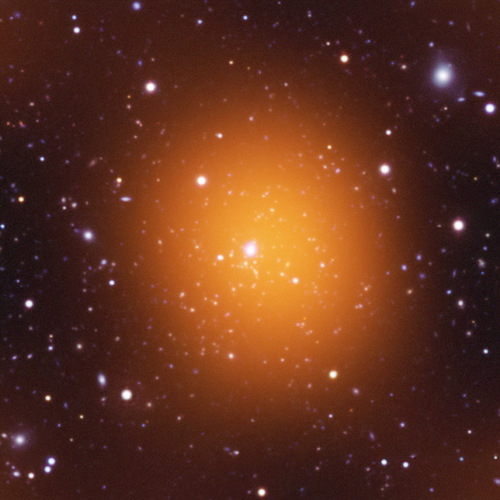 The SPT team has discovered an extraordinary galaxy cluster. This massive system, known as the Phoenix Cluster, is forming stars at a spectacularly high rate -- more than 700 stars per year --- and its existence may force astronomers to rethink how galaxy clusters and the galaxies that inhabit them, evolve. Read more about this exciting new discovery here, And here's a link to an interview with SPT team members Mike McDonald and Brad Benson.
The SPT team has discovered an extraordinary galaxy cluster. This massive system, known as the Phoenix Cluster, is forming stars at a spectacularly high rate -- more than 700 stars per year --- and its existence may force astronomers to rethink how galaxy clusters and the galaxies that inhabit them, evolve. Read more about this exciting new discovery here, And here's a link to an interview with SPT team members Mike McDonald and Brad Benson.
(Page 1 of 5, totaling 41 entries)
» next page
Calendar
|
|
November '25 | |||||
| Mon | Tue | Wed | Thu | Fri | Sat | Sun |
| 1 | 2 | |||||
| 3 | 4 | 5 | 6 | 7 | 8 | 9 |
| 10 | 11 | 12 | 13 | 14 | 15 | 16 |
| 17 | 18 | 19 | 20 | 21 | 22 | 23 |
| 24 | 25 | 26 | 27 | 28 | 29 | 30 |
Categories
Syndicate This Blog
Statistics
Last entry: 2014-01-28 04:43
41 entries written
